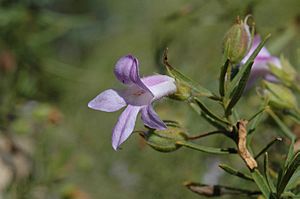Purple fuchsia bush facts for kids
Quick facts for kids Purple fuchsia bush |
|
|---|---|
 |
|
| Scientific classification | |
| Genus: |
Eremophila (plant)
|
| Species: |
goodwinii
|
| Synonyms | |
|
|
The purple fuchsia bush (Eremophila goodwinii) is a beautiful flowering plant. It is also called Goodwin's emu bush. This plant belongs to the figwort family. It grows naturally only in Australia. It is a small shrub that can spread out or grow upright. Most parts of the plant feel sticky because of a natural substance called resin. It has long, thin leaves and pretty flowers that are light purple or pinkish-purple. You can find it in New South Wales, the Northern Territory, and Queensland.
Contents
What the Purple Fuchsia Bush Looks Like
The purple fuchsia bush is usually a low, spreading shrub. Sometimes, it grows as an upright shrub. It can reach a height of about 0.3 to 1.5 m (1 to 5 ft). Its branches and leaves often feel sticky. This stickiness comes from a natural substance called resin.
The leaves grow one after another along the stems. They are usually 28–58 mm (1–2 in) long. They are also 2–4 mm (0.08–0.2 in) wide. The leaves are long and narrow, like a spear. Their edges can be smooth or have small teeth.
Flowers and Fruits
The flowers grow alone or in pairs. They appear where the leaves meet the stem. Each flower has a stalk that is 15–30 mm (0.6–1 in) long. There are five green or purplish sepals. These are like small leaves that protect the bud. They are 8–15 mm (0.3–0.6 in) long. They are covered with tiny hairs that produce a sticky substance.
The petals are 15–30 mm (0.6–1 in) long. They join together at the bottom to form a tube. The outside of this tube is light purple or pinkish-purple. The inside is white with dark lines. The outside of the tube and the petal tips are hairy. The inside of the tips is smooth. The inside of the tube is soft and woolly.
This plant has four stamens. These are the parts that make pollen. They are completely hidden inside the petal tube. The purple fuchsia bush flowers all year round. After flowering, it produces fruits. These fruits are oval or almost round. They are 8–11 mm (0.3–0.4 in) long. They have a hairy, papery covering.
How the Plant Got Its Name
The purple fuchsia bush was first officially described in 1859. This was done by a scientist named Ferdinand von Mueller. He published his description in a report about plants found during an expedition. The plant's specific name, goodwinii, honors Reverend Thomas Hill Goodwin. He helped collect the first sample of this plant. This sample was found near Mount Murchison, by the Murray River.
Where the Purple Fuchsia Bush Lives
In New South Wales, this plant is common. You can find it on the central west slopes, north of Parkes. It also grows on the north-west plains. It prefers red soil, flat sandy areas, and rocky hillsides. It is also found in nearby parts of Queensland. There are also scattered groups of this plant further north in Queensland. You can also see it in the southern central Northern Territory. A small area of Western Australia also has this plant.
How People Use the Purple Fuchsia Bush
Traditional Uses
Aboriginal people used the leaves of this plant. They would make a special liquid from the leaves. This liquid was used as a medicinal wash. It was also believed that the leaves could help with digestion.
Growing it in Gardens
The purple fuchsia bush is a pretty shrub for gardens. However, it sometimes does not live very long in gardens. You can grow new plants from cuttings. You can also grow it by grafting it onto a Myoporum plant. It grows best in full sun. It also needs soil that drains water well. This plant can handle dry conditions. Heavy frost can harm it. But light trimming can help it stay healthy and keep its shape.
Conservation Status
The purple fuchsia bush is not considered to be in danger. The Western Australian Government Department of Parks and Wildlife says it is "not threatened". In the Northern Territory and Queensland, it is listed as being of "least concern". This means there are plenty of these plants.

